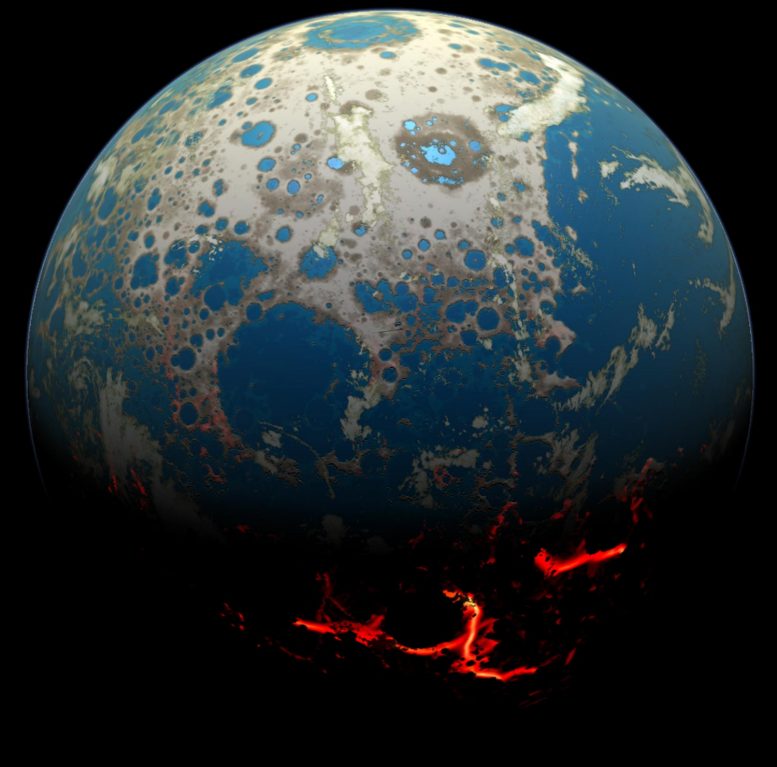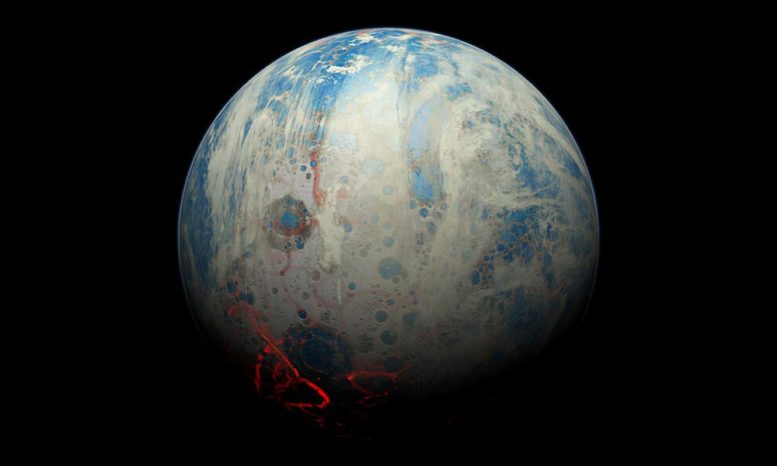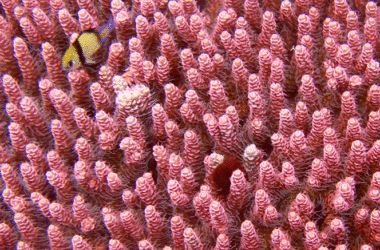
Une conception d’artiste de la Terre primitive. Crédit : Simone Marchi/SwRI
Des chercheurs de Yale et de Caltech ont une nouvelle théorie audacieuse pour expliquer comment la Terre s’est transformée d’une boule de roches ardente et nuageuse de carbone en une planète capable d’accueillir la vie.
La théorie couvre les premières années de la Terre et implique des roches “étranges” qui ont interagi avec l’eau de mer de la bonne manière pour faire naître la matière biologique.
“Cette période est la plus énigmatique de l’histoire de la Terre”, a déclaré Jun Korenaga, professeur de sciences de la Terre et des planètes à Yale et co-auteur d’une nouvelle étude publiée dans la revue Nature. “Nous présentons la théorie la plus complète, de loin, pour les 500 premiers millions d’années de la Terre”.
Le premier auteur de l’étude est Yoshinori Miyazaki, un ancien étudiant diplômé de Yale qui est maintenant un postdoctorant de Stanback à Caltech. L’étude est basée sur le dernier chapitre de la thèse de Yale de Miyazaki.
La plupart des scientifiques pensent que la Terre a commencé avec une atmosphère semblable à celle de la planète Venus. Its skies were filled with carbon dioxide — more than 100,000 times the current level of atmospheric carbon — and Earth’s surface temperature would have exceeded 400 degrees Fahrenheit.
Biological life would have been unable to form, much less survive, under such conditions, scientists agree.

Artist’s conception of the early Earth. Credit: Simone Marchi, Southwest Research Institute
“Somehow, a massive amount of atmospheric carbon had to be removed,” Miyazaki said. “Because there is no rock record preserved from the early Earth, we set out to build a theoretical model for the very early Earth from scratch.”
Miyazaki and Korenaga combined aspects of thermodynamics, fluid mechanics, and atmospheric physics to build their model. Eventually, they settled on a pretty bold proposition: early Earth was covered with rocks that do not currently exist on Earth.
“These rocks would have been enriched in a mineral called pyroxene, and they likely had a dark greenish color,” Miyazaki said. “More importantly, they were extremely enriched in magnesium, with a concentration level seldom observed in present-day rocks.”
Miyazaki said magnesium-rich minerals react with carbon dioxide to produce carbonates, thereby playing a key role in sequestering atmospheric carbon.
The researchers suggest that as the molten Earth started to solidify, its hydrated, wet mantle — the planet’s 3,000-kilometer-thick rocky layer — convected vigorously. The combination of a wet mantle and high-magnesium pyroxenites dramatically sped up the process of pulling CO2 out of the atmosphere.
In fact, the researchers said the rate of atmospheric carbon sequestration would have been more than 10 times faster than would be possible with a mantle of modern-day rocks, requiring a mere 160 million years.
“As an added bonus, these ‘weird’ rocks on the early Earth would readily react with seawater to generate a large flux of hydrogen, which is widely believed to be essential for the creation of biomolecules,” Korenaga said.
The effect would be similar to a rare type of modern, deep-sea thermal vent, called the Lost City hydrothermal field, located in the Atlantic Ocean. The Lost City hydrothermal field’s abiotic production of hydrogen and methane has made it a prime location for investigating the origin of life on Earth.
“Our theory has the potential to address not just how Earth became habitable, but also why life emerged on it,” Korenaga added.
Grants from the National Aeronautics and Space Administration and the National Science Foundation helped to fund the research.



